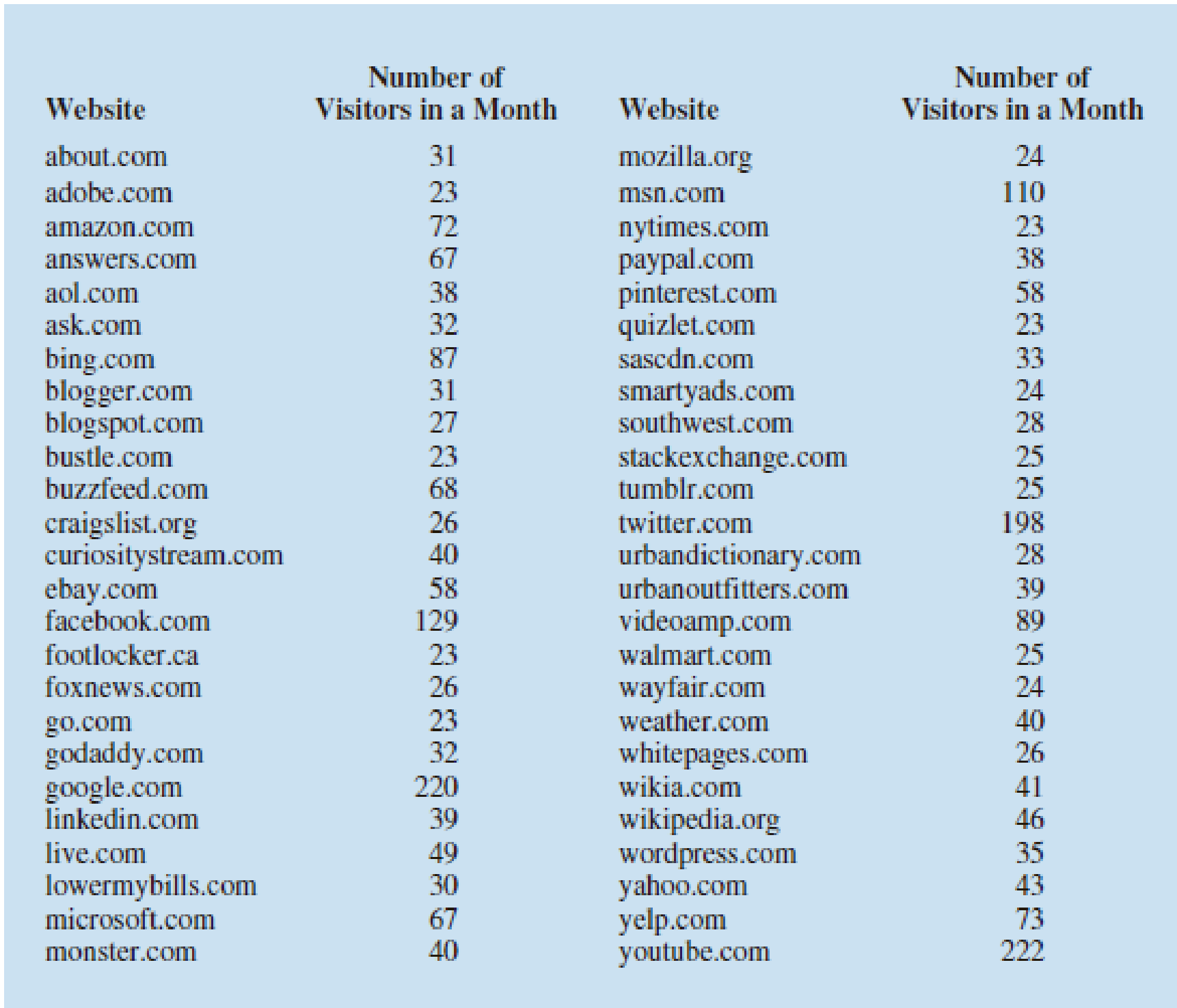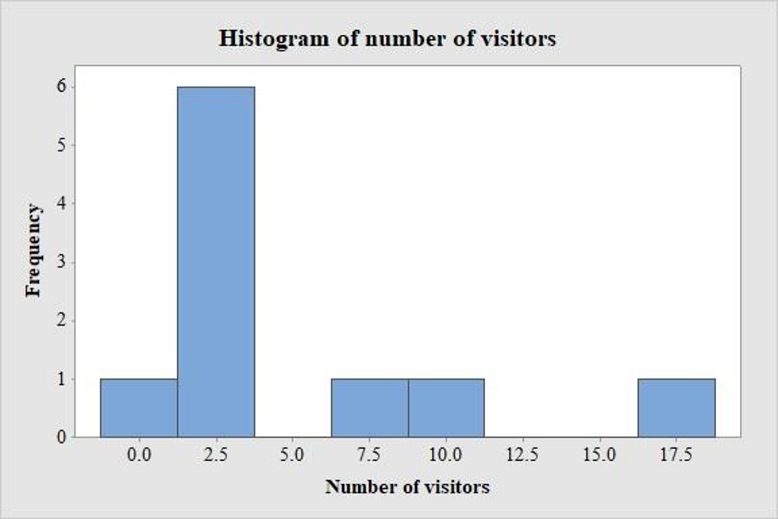
Quantcast.com provides the number of people from the United States who visit a given website. The list below shows the number of U.S. visitors for the 50 most highly visited websites (Quantcast.com website, December 2015).

Summarize the data by constructing the following:
- a. A frequency distribution (classes in millions: 20–29.999, 30–30.999, and so on).
- b. A relative frequency distribution.
- c. A cumulative distribution.
- d. A cumulative relative frequency distribution.
- e. Show a histogram. Comment on the shape of the distribution.
- f. What is the website with the most U.S. visitors? How many people from the U.S. visited the site?
a.
Construct a frequency distribution for the data.
Answer to Problem 21E
The frequency distribution is as follows:
| Number of visitors in a month | Frequency |
| 20-29.999 | 18 |
| 30-39.999 | 11 |
| 40-49.999 | 7 |
| 50-59.999 | 2 |
| 60-69.999 | 3 |
| 70-79.999 | 2 |
| 80-89.999 | 2 |
| 90-99.999 | 0 |
| 100-199.999 | 3 |
| 200-299.999 | 2 |
| Total | 50 |
Explanation of Solution
Calculation:
The data represents the number of visitors from country C for the 50 most highly visited websites. The frequency distribution is constructed using the class 20-29.999, 30-39.999, and so on.
Frequency:
The frequencies are calculated using the tally mark and the range of the data is from 0 to 100.999.
- Based on the given information, the class intervals are 20-29.999, 30-39.999, 40-49.999, …, 200-299.999.
- Make a tally mark corresponding to each number of visitors in a month and continue for all values in the data.
- The number of tally marks in each class represents the frequency, f of that class.
Similarly, the frequency of remaining classes for the number of visitors in a month is given below:
| Number of visitors in a month | Tally | Frequency |
| 20-29.999 | 18 | |
| 30-39.999 | 11 | |
| 40-49.999 | 7 | |
| 50-59.999 | 2 | |
| 60-69.999 | 3 | |
| 70-79.999 | 2 | |
| 80-89.999 | 2 | |
| 90-99.999 | 0 | |
| 100-199.999 | 3 | |
| 200-299.999 | 2 | |
| Total | 50 |
b.
Construct a relative frequency distribution for the data.
Answer to Problem 21E
The relative frequency distribution is as follows:
| Number of visitors in a month | Frequency | Relative frequency |
| 20-29.999 | 18 | 0.36 |
| 30-39.999 | 11 | 0.22 |
| 40-49.999 | 7 | 0.14 |
| 50-59.999 | 2 | 0.04 |
| 60-69.999 | 3 | 0.06 |
| 70-79.999 | 2 | 0.04 |
| 80-89.999 | 2 | 0.04 |
| 90-99.999 | 0 | 0.00 |
| 100-199.999 | 3 | 0.06 |
| 200-299.999 | 2 | 0.04 |
| Total | 50 | 1.00 |
Explanation of Solution
Calculation:
Relative frequency:
The general formula for the relative frequency is as follows:
For the revenue class (20-29.999), substitute frequency as “18” and total frequency as “50”.
Similarly, the relative frequencies for the remaining number of visitors in a month are obtained as follows:
| Number of visitors in a month | Frequency | Relative frequency |
| 20-29.999 | 18 | 0.36 |
| 30-39.999 | 11 | 0.22 |
| 40-49.999 | 7 | 0.14 |
| 50-59.999 | 2 | 0.04 |
| 60-69.999 | 3 | 0.06 |
| 70-79.999 | 2 | 0.04 |
| 80-89.999 | 2 | 0.04 |
| 90-99.999 | 0 | 0.00 |
| 100-199.999 | 3 | 0.06 |
| 200-299.999 | 2 | 0.04 |
| Total | 50 | 1.00 |
c.
Construct a cumulative frequency distribution for the data.
Answer to Problem 21E
The cumulative frequency distribution is as follows:
| Number of visitors in a month | Frequency | Cumulative frequency |
| 20-29.999 | 18 | 18 |
| 30-39.999 | 11 | 29 |
| 40-49.999 | 7 | 36 |
| 50-59.999 | 2 | 38 |
| 60-69.999 | 3 | 41 |
| 70-79.999 | 2 | 43 |
| 80-89.999 | 2 | 45 |
| 90-99.999 | 0 | 45 |
| 100-199.999 | 3 | 48 |
| 200-299.999 | 2 | 50 |
| Total | 50 | 50 |
Explanation of Solution
Calculation:
Cumulative frequency:
Cumulative frequency of a particular class is the sum of all frequencies up to that class. The last class’s cumulative frequency is equal to the sample size
The cumulative frequency for each class is tabulated as follows:
| Number of visitors in a month | Relative frequency | Cumulative relative frequency |
| 20-29.999 | 0.36 | 0.36 |
| 30-39.999 | 0.22 | |
| 40-49.999 | 0.14 | |
| 50-59.999 | 0.04 | |
| 60-69.999 | 0.06 | |
| 70-79.999 | 0.04 | |
| 80-89.999 | 0.04 | |
| 90-99.999 | 0.00 | |
| 100-199.999 | 0.06 | |
| 200-299.999 | 0.04 | |
| Total | 1.00 | 1.00 |
d.
Construct a cumulative relative frequency distribution for the data.
Answer to Problem 21E
The cumulative relative frequency distribution is as follows:
| Number of visitors in a month | Cumulative relative frequency |
| 0-49 | 0.12 |
| 50-99 | 0.70 |
| 100-149 | 0.92 |
| 150-199 | 0.92 |
| 200-249 | 0.94 |
| 250-299 | 0.96 |
| 300-349 | 0.96 |
| 350-399 | 0.96 |
| 400-449 | 1.00 |
Explanation of Solution
Calculation:
Cumulative relative frequency of a particular class is the sum of all relative frequencies up to that class. The last class’s cumulative relative frequency is equal to the approximate value 1.00.
The relative frequencies for the number of visitors in a month from part (b) are given below:
| Number of visitors in a month | Frequency | Relative frequency |
| 20-29.999 | 18 | 0.36 |
| 30-39.999 | 11 | 0.22 |
| 40-49.999 | 7 | 0.14 |
| 50-59.999 | 2 | 0.04 |
| 60-69.999 | 3 | 0.06 |
| 70-79.999 | 2 | 0.04 |
| 80-89.999 | 2 | 0.04 |
| 90-99.999 | 0 | 0.00 |
| 100-199.999 | 3 | 0.06 |
| 200-299.999 | 2 | 0.04 |
| Total | 50 | 1.00 |
The cumulative relative frequencies for the number of visitors in a month are obtained below:
| Number of visitors in a month | Relative frequency | Cumulative relative frequency |
| 20-29.999 | 0.36 | 0.36 |
| 30-39.999 | 0.22 | |
| 40-49.999 | 0.14 | |
| 50-59.999 | 0.04 | |
| 60-69.999 | 0.06 | |
| 70-79.999 | 0.04 | |
| 80-89.999 | 0.04 | |
| 90-99.999 | 0.00 | |
| 100-199.999 | 0.06 | |
| 200-299.999 | 0.04 | |
| Total | 1.00 | 1.00 |
e.
Construct the histogram and comment on the shape of the distribution.
Answer to Problem 21E
- Output using MINITAB software is given below:

The histogram is skewed to the right.
Explanation of Solution
Calculation:
Step by step procedure to draw the frequency histogram chart using MINITAB software is as follows:
- Choose Graph > Histogram.
- Choose Simple, and then click OK.
- In Graph variables, enter the Number of visitors column of data.
- In scale on y-axis, make click on frequency.
- Click on ok.
Skewness:
The data is said to be skewed if there is lack of symmetry, and the values fall on one side that can be either left or right of the distribution.
Right skewed:
If the tail on the distribution is elongated towards the right, and moreover it attains its peak rapidly than its horizontal axis and then it is a right skewed distribution. It is also called positively skewed.
The distribution of number of visitors in the histogram has elongated tail towards right side.
Therefore, the distribution of the histogram with number of visitors is skewed right.
f.
Find the website with the most number of visitors from country U and find corresponding number.
Answer to Problem 21E
Youtube.com is website with the most number of visitors from country U and the number of people from country U, who visited the site is 222.
Explanation of Solution
From the data set of 50 most highly visited websites, it is observed that highly visited websites is Youtube.com, and number of people from country U that visited the site is 222.
The second highly visited websites is google.com, and number of people from country U that visited the site is 220.
Want to see more full solutions like this?
Chapter 2 Solutions
Bundle: Modern Business Statistics with Microsoft Office Excel, Loose-Leaf Version, 6th + MindTap Business Statistics, 2 terms (12 months) Printed Access Card
- Let X be a random variable with support SX = {−3, 0.5, 3, −2.5, 3.5}. Part ofits probability mass function (PMF) is given bypX(−3) = 0.15, pX(−2.5) = 0.3, pX(3) = 0.2, pX(3.5) = 0.15.(a) Find pX(0.5).(b) Find the cumulative distribution function (CDF), FX(x), of X.1(c) Sketch the graph of FX(x).arrow_forwardA well-known company predominantly makes flat pack furniture for students. Variability with the automated machinery means the wood components are cut with a standard deviation in length of 0.45 mm. After they are cut the components are measured. If their length is more than 1.2 mm from the required length, the components are rejected. a) Calculate the percentage of components that get rejected. b) In a manufacturing run of 1000 units, how many are expected to be rejected? c) The company wishes to install more accurate equipment in order to reduce the rejection rate by one-half, using the same ±1.2mm rejection criterion. Calculate the maximum acceptable standard deviation of the new process.arrow_forward5. Let X and Y be independent random variables and let the superscripts denote symmetrization (recall Sect. 3.6). Show that (X + Y) X+ys.arrow_forward
- 8. Suppose that the moments of the random variable X are constant, that is, suppose that EX" =c for all n ≥ 1, for some constant c. Find the distribution of X.arrow_forward9. The concentration function of a random variable X is defined as Qx(h) = sup P(x ≤ X ≤x+h), h>0. Show that, if X and Y are independent random variables, then Qx+y (h) min{Qx(h). Qr (h)).arrow_forward10. Prove that, if (t)=1+0(12) as asf->> O is a characteristic function, then p = 1.arrow_forward
- 9. The concentration function of a random variable X is defined as Qx(h) sup P(x ≤x≤x+h), h>0. (b) Is it true that Qx(ah) =aQx (h)?arrow_forward3. Let X1, X2,..., X, be independent, Exp(1)-distributed random variables, and set V₁₁ = max Xk and W₁ = X₁+x+x+ Isk≤narrow_forward7. Consider the function (t)=(1+|t|)e, ER. (a) Prove that is a characteristic function. (b) Prove that the corresponding distribution is absolutely continuous. (c) Prove, departing from itself, that the distribution has finite mean and variance. (d) Prove, without computation, that the mean equals 0. (e) Compute the density.arrow_forward
- 1. Show, by using characteristic, or moment generating functions, that if fx(x) = ½ex, -∞0 < x < ∞, then XY₁ - Y2, where Y₁ and Y2 are independent, exponentially distributed random variables.arrow_forward1. Show, by using characteristic, or moment generating functions, that if 1 fx(x): x) = ½exarrow_forward1990) 02-02 50% mesob berceus +7 What's the probability of getting more than 1 head on 10 flips of a fair coin?arrow_forward
 Glencoe Algebra 1, Student Edition, 9780079039897...AlgebraISBN:9780079039897Author:CarterPublisher:McGraw Hill
Glencoe Algebra 1, Student Edition, 9780079039897...AlgebraISBN:9780079039897Author:CarterPublisher:McGraw Hill Holt Mcdougal Larson Pre-algebra: Student Edition...AlgebraISBN:9780547587776Author:HOLT MCDOUGALPublisher:HOLT MCDOUGAL
Holt Mcdougal Larson Pre-algebra: Student Edition...AlgebraISBN:9780547587776Author:HOLT MCDOUGALPublisher:HOLT MCDOUGAL Big Ideas Math A Bridge To Success Algebra 1: Stu...AlgebraISBN:9781680331141Author:HOUGHTON MIFFLIN HARCOURTPublisher:Houghton Mifflin Harcourt
Big Ideas Math A Bridge To Success Algebra 1: Stu...AlgebraISBN:9781680331141Author:HOUGHTON MIFFLIN HARCOURTPublisher:Houghton Mifflin Harcourt


